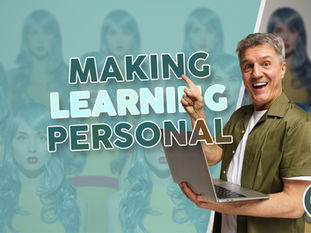
WCAG COMPLIANCE MADE SIMPLE: A PRACTICAL GUIDE FOR L&D TEAMS
1
2
0
Have you ever tried to complete a mandatory training module, only to find you can’t navigate it properly because you’re using a screen reader? Or you’re stuck because you can’t use a mouse?
Now imagine that happening every single day.
For millions of learners with disabilities, this isn’t a one-off frustration. It’s a regular reality. That’s why WCAG compliance matters, not just to tick a box, but to make learning genuinely inclusive.
And the good news? It’s simpler than you think to get it right.
Here’s everything your L&D team needs to know about creating eLearning courses that are accessible, compliant, and fair.

What Are WCAG Standards?
The Web Content Accessibility Guidelines (WCAG) are an internationally recognised set of rules that make web content, including eLearning, more accessible to people with disabilities.
They're built around four key principles. Good digital content must be:
Perceivable (people can see or hear it)
Operable (people can navigate it)
Understandable (people can comprehend it)
Robust (it works with a wide range of assistive technologies)
In short, WCAG is about designing for everyone, not just for people who use a mouse and have perfect vision.
Most organisations aim for WCAG 2.3 Level AA compliance, which strikes a balance between usability and practicality, and is often the legal standard under disability rights laws like the UK Equality Act 2010.
Why WCAG Compliance Matters for eLearning Developers
Accessible design is good design. Full stop.
When you design your Custom eLearning Content or Digital Learning Solutions with accessibility in mind, you:
Reach a wider audience
Improve learner satisfaction
Boost completion rates
Reduce legal risks
Strengthen your brand's social responsibility
At Popcorn, we bake accessibility into everything we do, because it’s not just about compliance. It’s about fairness, equity, and excellence.
WCAG 2.3 vs 2.2: What's New?
WCAG 2.3 isn’t a total reinvention but it builds on WCAG 2.2 with some crucial updates. Here’s a quick comparison:
WCAG 2.2 Features | WCAG 2.3 Changes |
Focus on mobile accessibility | Even stronger mobile touch target guidance |
Emphasis on time-based media alternatives | More support for complex gestures and device inputs |
Improvements for cognitive and learning disabilities | Expanded guidelines to simplify authentication processes (e.g., no "puzzle" CAPTCHAs) |
Better error identification and prevention | More intuitive navigation and fewer "dead ends" |
In simple terms, WCAG 2.3 raises the bar for mobile, simplicity, and user control. And for eLearning developers, that means even smoother, more intuitive course experiences.
Common WCAG Compliance Mistakes in eLearning
Even well-intentioned courses can accidentally exclude learners. Here are a few common pitfalls:
Colour-only information: Using colour to show correct/incorrect answers without text or icons.
Missing alt text: Leaving images, icons, or infographics without descriptive labels for screen readers.
Non-keyboard-friendly navigation: Designing drag-and-drop or hotspot interactions that only work with a mouse.
Inconsistent headings: Skipping heading levels (e.g., jumping from H1 to H4) confuses assistive technologies.
Video without captions or audio description: Excluding learners who are deaf or blind from critical content.
Poor contrast ratios: Light grey text on white backgrounds might look pretty, but it’s impossible for some users to read.
Golden Tips for Creating WCAG 2.3 AA-Compliant eLearning
Want to build beautiful, accessible, compliant courses? Here’s your cheat sheet:
Design for keyboard-first navigationAssume learners can't (or won’t) use a mouse. Test your entire course with just a keyboard tab.
Always add meaningful alt textDescribe images based on what matters to the learning, not just what you see.
Use clear, descriptive headingsStructure your content logically with H1, H2, H3 tags in order.
Prioritise contrast and readabilityUse tools like the WebAIM Contrast Checker to test your colour schemes.
Provide multiple ways to complete tasksFor example, allow keyboard shortcuts, voice commands, or text-based alternatives for drag-and-drop.
Caption all videos and describe the audioClosed captions and audio descriptions are essential for many learners.
Keep interactions simple and intuitiveNo complex gestures, no tricky puzzles to "prove you’re human", and no hidden navigation steps.
Test with real users and assistive technologiesSimulated testing isn’t enough. Use screen readers like NVDA and include users with disabilities in your QA.
Final Thought: Inclusion Is Innovation
Getting WCAG 2.3 AA right isn’t just about avoiding complaints. It’s about creating corporate training solutions and employee learning and development experiences that everyone can access, enjoy, and benefit from.
At Popcorn, we believe that inclusive learning is better learning, and we design every course to be as welcoming as it is engaging.
Because when we make learning accessible, we don’t just do the right thing.We do the smart thing.






